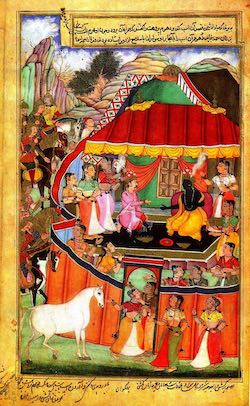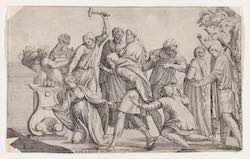Topic: 2. Sacrifice and religion: Comparisons, Antiquarians, Anthropology (16th-18th Century)
Religious sacrifices across various cultures and contexts sparked widespread interest in Early Modern Europe. As Christianity expanded into regions inhabited by "infidels" and "pagans", Europeans encountered a diverse array of sacrificial customs, ranging from the Sati rituals in India to the Aztec sacrifices in the Americas. This cross-cultural exposure captivated a wide audience, including theologians, philosophers, political thinkers, antiquarians, orientalists, missionaries, poets, artists, and even the general public. These encounters broadened the European understanding of sacrifice and led to a critical reassessment of classical and biblical sacrificial rites. This section includes:
- Sources: A selection of early modern printed materials, which include descriptions of the Americas, Asia, and Africa, alongside antiquarian and philological studies on religious sacrifice in classical antiquity and beyond. It also presents early modern works of ethnological observations and the first attempts to compare different sacrificial practices in various traditions and contexts, laying the groundwork for disciplines like the history of religions and anthropology.
- Iconographic Representations: A rich collection of images from the 16th to 18th centuries, illustrating a range of sacrificial rituals and practices as seen in different cultural and geographical contexts.
- Related Bibliography: An extensive bibliography spanning scholarly works from the 19th to 21st centuries, providing contemporary analyses and interpretations of these early studies and observations.
El Laocoonte y el tema del Sacrificio entre el Renacimiento y la Contrarreforma
in: Goya. Revista de Arte, v. 269 (1999), issue : pp.112-124.
From Crusades to Blood Libels to Expulsions: Some new approaches to Medieval antisemitism
in: Second Annual Lecture of the Victor J. Selmanowitz Chair of Jewish History, pp. 1-29
New York: Touro College, 1997.
Scholarship and the Blood Libel: Past and Present
in: Confronting Antisemitism from the Perspectives of Christianity, Islam, and Judaism (vol. 2), pp. 71-86
Berlin: De Gruyter, 2020.
Antigüedad y excelencias de Granada. Edición facsímil
Granada: Comisión Organizadora de la Feria Provincial del Libro de Granada, 2000.
Historia eclesiástica de Granada. Edición facsímil
Granada: Editorial Don Quijote, 1989.
Antigüedad y excelencias de Granada. Edición facsímil
Granada: Colegio Oficial de Arquitectos de Andalucía Oriental, 1981.
Commentarii a Philippo Beroaldo conditi in Asinum Aureum Lucii Apulei
Bologna: Benedicto Hectoris, 1500.
Bronze Age Sacrificial Koine in the Eastern Mediterranean? A Study of Animal Sacrifice in the Ancient Near East
in: Ritual and Sacrifice in the Ancient Near East, pp. 11-43
Leuven: Peeters, 1993.
La technique des prescriptions sacrificielles dans la géomancie bambara (région de Ségou, Mali
in: ystèmes de pensée en Afrique noire, v. 6 (1983), issue : pp.117-130.
Deorum sacrificiorumque gentilium descriptio
Coloniae: Conradum Butgenium, 1606.
Of Summits and Sacrifice: An Ethnohistoric Study of Inka Religious Practices
Austin: University of Texas Press, 2009.
Ladies of Krishna's Harem are Shown the Sacrificial Horse (1598)
from: Razmnama Mughal
Oriental and India Office Collection, British Library, London
in: Blood and Belief: The Circulation of a Symbol between Jews and Christians, pp.
Berkeley: University of California Press, 2007.
Sacrifice of Iphigenia (17th Century)
Metropolitan Museum of Art, New York
Le sacrifice dans l'Inde ancienne
Paris: Presses universitaires de France, 1976.
Anshen Liming or the Religious Dimension of Confucianism
in: China Perspectives, v. 3 (2008), issue : pp.88-106.


